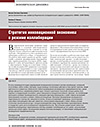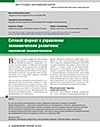

The article analyzes the model of forming an innovative economy in a collaborative system based on the stable links of network partners that carry out collective actions on the basis of a common strategy, common identity and joint commitments in the aspect of forming innovative entrepreneurship in order to select the priority directions for developing science, technology and critical technologies that should be aimed at modernizing the economy in order to increase its competitiveness. It is proved that collaboration multiplies many times the productivity of existing production factors and serves as the main mechanism for balancing economies in the global competition conditions. The article justifies formation of an innovative territorial cluster as an aggregate of agents that establish homogeneous, multilateral and regularly recurring links for the joint use of information and knowledge, exchange of services and acquisition of economic benefits from the position of interaction between representatives of science/education, business and the state in order to promote the growth of innovative entrepreneurship. With successful deployment of joint initiatives, innovative territorial clusters develop the collaboration to such level where a unique network effect of innovative synergies (flow innovations) arises, which ensures the continuous growth of innovative entrepreneurship.
Продолжить чтение





